
|   |

|   |
Mudra -The Language of Kutiyattam, Kathakali and Mohiniyattam - Tapati Chowdhurie e-mail: tapatichow@yahoo.co.in Photos courtesy: Natanakairali July 4, 2023 (Printing of Mudra is by Ebenezer Print Pack and published by Natanakairali. Price: Rs.3000) My salutations to my guru, Guru Gopinath, whose blessings I seek before embarking on expressing my views about the mammoth work of G. Venu, my gurubhai. 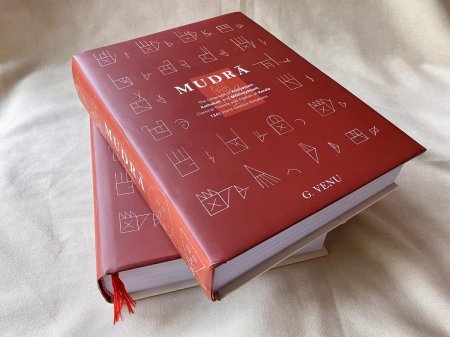
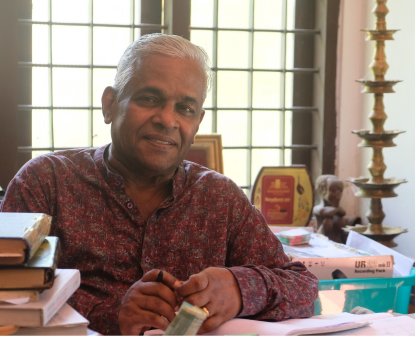 G Venu The author G. Venu, born on first July 1945, belongs to a family of artists. Living in a small thatched house on top of a hill with rolling paddy fields on all sides, he spent a charming childhood in a pristine rural locality. While in his fifth grade, a turning point in his life came when he saw the Kathakali drama Narakasuravadham. It ignited his desire to enter the world of Kathakali. He began his training under Keerikattu Sankara Pillai Asan in the Attakalari founded by his father. The study of the 24 basic mudras and their applications fascinated him, made him magically create elephants, snakes and other animals when he negotiated lonely landscapes. The second phase of embellishing his Kathakali learning started in 1963, when he entered Viswakala Kendra in Vattiyoorkavu, Thiruvananthapuram established by Guru Gopinath - one of the most famous dancers in India - more or less in the gurukulam tradition. The compelling charm of Guru Gopinath's pictures of his abhinaya of the Navarasa made him his ardent admirer. He found Guru Gopinath to be a rare personality worthy of emulation. 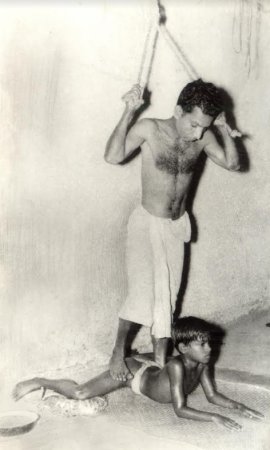 Keerikattu Sankara Pillai and his disciple G Venu (1956); massage during Kathakali training (Credit: Chittoor Gopalan Nair) Venuji was taught steps and kalasams in Kaplinnatan style - the style of Southern Kathakali established by the great Mathur Kunju Pillai Paniker. Seeing his interest, Guru Gopinath used to specially train him for two hours every day, explaining in detail the concepts behind every gesture, expression and movement. Every day he introduced innovations using a blend of traditional knowledge and his own imaginative improvisations. Guru Gopinath approached the concept of abhinaya with an analytical mind, said Venuji. He enabled the common man's access to the Hastalakshanadipika, the scientific text of hand gestures. Training under the great guru revealed to him the infinite possibilities of Kathakali mudras. It was in Viswakala Kendra that the first sparks of an idea to record and inscribe these mudras like a spoken language (Kathakali gestures offer a complete vocabulary of communication, capable of expressing each and every human thought and emotions more forcefully with mudras) occurred to Venuji. The realization that many rare aspects of the mudras in Kathakali would disappear over time, simply because they were not documented or recorded anywhere flashed in his mind, since they were sustained thus far only by oral tradition. Venuji was obsessed day and night with the idea. The need to develop a proper alphabet to document this sign language became his preoccupation. It was an eureka moment, when on a rainy night in 1965, recalled Venuji, he sat in his father's studio preoccupied with the idea of finding the most suitable medium that would help to record the mudras. The scenes of full night's performances of stalwarts like Chengannur Raman Pillai Asan and Kalamandalam Krishnan Nair at Padmanabhaswamy temple passed before his mind's eye, the alphabet of the first mudra – Pataka - saw the light of day. Like the torrential rain raging outside, the alphabets of all the 24 mudras flowed into his mind as he sat drawing them with black ink and gazed at them with satisfaction till four in the morning until sleep overtook him. In days to come, he formulated a system of delineation to represent variations in hasta mudras. He analysed and deconstructed the minute movements of the wrists and fingers and conceived and evolved the signs and special graphic symbols. Illustrating the mudras on paper happened naturally to him. During holidays, he burnt his midnight oil drawing symbols to represent the mudras. It was an elaborate process. He made sure that the delineation of these were perfect, repeating the mudras over and over again to grasp the subtleties of each movement. Sankara Pillai Asan helped him greatly in this. Venuji spent his prime time in researching hand gestures. He sat through Kathakali programs, noting down the mudras he did not know and made a short-hand note and sought clarification from gurus. When he had documented about 300 mudras, he showed them to Guru Gopinath, who studied them minutely, while trying to execute some of them following the pictorial instructions. He then advised his disciple Gopal to ask Guru Chengannur Raman Kutty Pillai, an authority on mudras in the Kaplinnatan style to examine the notations and authenticate them. 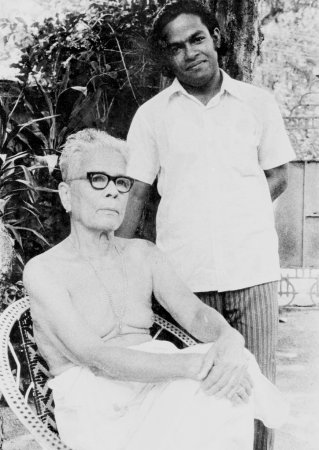 G Venu with Guru Chengannur Raman Pillai (1976) Venuji was so consumed with the idea of notations that he stopped a majority of his dance related activities to devote most of his time in the pursuit of his desired goal. He took up bare minimum work only to sustain himself. At that juncture, on a rainy day, he travelled to Chengannur with his manuscript of notations and reached Guru Raman Kutty's house, soaking wet. There he was received with grace and spent two weeks discussing his mudra notations, whenever Asan - who was a seasoned expert in the rules and systems of traditional Kathakali - had some free time to devote to young Gopal Venu. After this first meeting, Venuji had several other occasions to spend time with Asan, to discuss Kathakali mudras. Guru Kalamandalam Krishnan Nair was another stalwart who inspired Venu in his journey of exploration with mudras. Over time his documented collection of mudras kept growing, when he met M.K.K. Nair , the then Chairman of Kerala Kalamandalam, who took the initiative of publishing an article with images of Venuji's work as the cover story of the quarterly magazine of Kerala Kalamandalam. Gradually, Venuji's work became a huge compendium of mudras and a curious piece of news in Kathakali circles. Some praised his hard and creative work, while others questioned. He realised that it was important to get expert opinion on the graphic symbols he had evolved in the mudras. K.C.S. Paniker was a renowned artist whom Venuji went to meet in Madras. Though occupied with his artistic work, the veteran thoroughly examined the system of graphic symbols Venuji had developed for the basic mudras and asked him to demonstrate some of them. He then said, "Look, these symbols have taken shape from the over-brimming desire of your heart. Therefore, this work will certainly satisfy your needs". He then pointed out how Indian painting speaks differently on realism. "Indian concept of art depicts what lies beyond what we see with our eyes". Venuji instantly felt that in his explanation he had explained everything he needed to know. A Guru is one who not only passes on the knowledge of a given field but also inspires the new generation. This encounter left an indelible impression in Venuji's mind. For proper guidelines on the arrangement and composition of a Kathakali Mudra dictionary, Venuji had next approached N.V. Krishna Warrior, the renowned linguist and an attakkatha writer and a veritable encyclopaedia of classical performing arts. On his advice, Venu published a pamphlet in English, titled 'Alphabet of gestures in Kathakali' introducing his system of notation and the important work-in-progress on mudras. N.V. Krishna Warrior wrote a scholarly and encouraging foreword to it. They were sent to scholars in India and abroad. Venuji has interacted with many more greats from all around Kerala in his pursuit to document Kathakali mudras like: Kadathanattu K.Kunjunni Warrier, Kochu Govindan Asan, Guru Kizhpadam Kumaran Nair, Guru Chathunni Paniker, Asan Pallippuram Gopalan Nair, Kaitakkatu Raman Pillai, Asan Sadanam Krishnan Kutty, Nelliyode Vasudevan Namboodiri, Asan Kalamandalam Rajan, Chandramana Govindan Nambutiri, V.P. Ramakrishnan Nair, Injakkattu Rama Chandran Pillai and others. In 1977, the Kerala Sangeetha Nataka Akademi published Kathakaliyile Kai Mudraka (The hand gestures in Kathakali), a compilation of 373 mudras from Venuji's collection along with a foreword written by Kapila Vatsyayan. The second edition of the book was published by the Akademi. In 1994 the Department of Cultural Publication, Government of Kerala, published Kathakali Mudra Nighantu (Kathakali Mudra Dictionary), a collection of 587 mudras notated by G.Venu. In 2000, Natanakairali published a more comprehensive collection of 874 mudras under the title of Language of Kathakali. Venuji brimmed with pride for having documented Kathakali Mudras in six editions. Alongside documenting Kathakali mudras, he took it upon himself to document gestures in Mohiniyattam, the lasya dance of Kerala too. G, Venu's work on Mohiniyattam commenced when in 1977 Kerala Sangeetha Nataka Akademi organised a workshop on all the classical dances directed by Guru Gopinath, where gurus as well as Venuji had participated in lecture demonstrations and discussions, with prominent Mohiniyattam scholars and performers like Guru Kalyanikutty Amma and Guru Satyabhama, that he felt the need to study in detail the mudras of this dance form as well. With the help of his wife Nirmala Paniker, a disciple of Kalyanikutty Amma, he completed notating the mudras of the existing Mohiniyattam repertoire. Their research confirmed that most of the hand gestures of Mohiniyattam were based on Hastalakshanadipika which should be considered as the source text for Mohiniyattam. In 1983, Natanakairali published Mohiniyattam - Attaprakaravurh Mudrakalum with a notation of 207 mudras and postures. In 1995, a more elaborate version in English with the title "Mohiniyattam , The Lasya Dance" was published. Venu's journey in the arts of Kerala made him take a dive into the sea of knowledge in Kutiyattam, an ancient art form that evolved over time and presented Sanskrit plays using indigenous styles. The concepts of Natya or theatre as well as the vigour and vitality of all the folk and ritual arts of Kerala that Venuji had seen and known were internalised by him. Kutiyattam is an art form in which the plays composed by great poets like Bhasa are enacted by actors with the objective of evoking rasa or aesthetic pleasure in the sahrdayas sitting in front of the Rangamandapa in the Koothambalam. While the acting concepts of Kutiyattam are essentially stylized or Natyadharmi, the experience evoked in the minds of the spectators is realistic or Lokadharmi. It was only after Venuji had seen Ammanur Madhava Chakyar's performance in the Trichur Koothambalam, did he realize that Kerala's abhinaya tradition was still very much alive in Kutiyattam. At first, Venuji took upon himself the role of a research scholar in Kutiyattam, with only informal training in the art form, but soon realized that he had to become a Kutiyattam artiste who has had a Arannettam according to the prescribed rules. The most salutary contribution of Kutiyattam to Kerala's performance arts is the narration of story through a system of hand gestures. Hastabhinaya as a branch of acting evolved from the potential of the hands to express thoughts and emotions. While emoting, says Venuji, the eyes and mind are focused on conveying ideas and images created by the hands in empty space. The connection established between the hands and the mind is what produces and sustains the natural emotions. 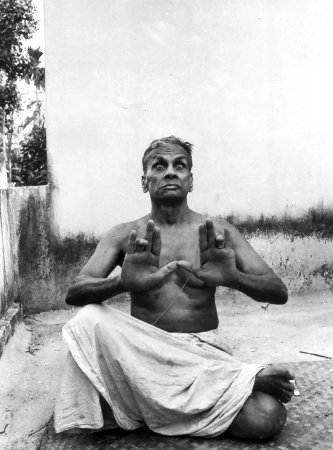 Guru Ammannur Madhava Chakyar demonstrating the mudra, the Sun With Kutiyattam training, Venuji's research into mudras made great progress. On May 18, 2001, when Kutiyattam was declared by UNESCO as "A masterpiece of the oral and intangible heritage of humanity", it attracted the attention of the world. The Department of Culture of the Government of India and the Sangeet Natak Akademi initiated projects for its conservation. Bhasa is the pioneer playwright of Indian theatre; the manuscripts of the 13 plays of Bhasa were discovered in the houses of Chakyars in Kerala. There was continuity in tradition, actors were able to get training in the acting concepts that were preserved unbroken. When Venuji became a Kutiyattam artiste, he continued his work on mudras and wrote a book on the mudras of Kutiyattam in what is named Ramayana Samkshepam published in 2013. It reveals the story of Ramayana through hand gestures, which are shown according to Attaprakaram - manual of acting. As each word is perceived in thought, the mind imbibes and manifests its essence and the hand gestures become uniquely lively. These hand gestures were formulated from the gesticulations used in daily life, which is why Samkshepam continues to be a method of story-telling that comes from the heart. Venu learnt Ramayana Samkshepam from Ammannur Madhava Chakyar, where according to tradition, the usual rituals, the Attaprakaram of Ramayana Samkshepam would be recited while Venu, his disciple would follow demonstrating the mudras as taught by his guru. The pupil recorded each and every mudra performed as per custom, according to the notation system between December 1982 to April 1985. Venuji was able to get it documented by Sangeet Natak Akademi in 1982, featuring Madhava Chakyar demonstrating the gestures of Ramayana Samkshepam supported by his explanations. This work is considered to be the most authentic document of Kutiyattam. Ramayana Samkshepam is the manual of acting for narrating the story of Ramayana through hand gestures; all important mudras of Kutiyattam are included in this manual. In 1985, he had completed a manuscript of the Attaprakaram (acting manual) after studying thoroughly and notating all the mudras. Many years later, Venuji thought about the numerous books he had made for himself, which could be compiled and published in a book form. His guru Ammannur Madhava Chakyar had taught him Kutiyattam for many years but was no longer in their midst. Besides teaching him mudras, Ammannur Madhava Chakyar also had shared with him memories of his own learning experiences at the Chakyar Madhom in the past, which the senior guru had demonstrated to him through his unparalleled histrionic prowess and had explained their meanings to him in an informal manner. 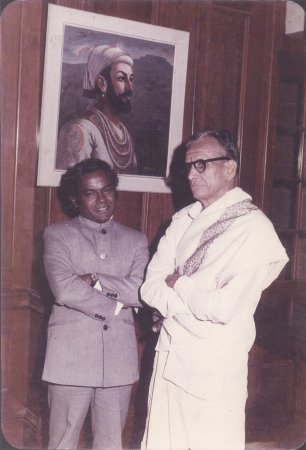 G. Venu and Ammannur Madhava Chakyar at the High Commission of India in London (1982) This book was made possible also due to the efforts of many others. The list is long. Ohhuki Misako, Deputy Director of International Research Centre for Intangible Cultural Heritage in the Asia-Pacific region in Japan, greatly appreciated Venuji's effort towards the complete documentation of Kutiyattam Mudras through notations, photographs and videos. According to her, the book Ramayana Samkshepam showed them the best practice in the field of documentation. Venuji is lucky to have succeeded in publishing this book and lucky are his readers, performers and dance aficionados, who would be perusing this book. He is gratified that the 1341 mudras notated, evolving a notation system of mudras will always remain the most important of all his creative endeavours. At long last the printed book has seen the light of day in a single volume of 744 pages in the month of March in 2023. To achieve this, often he has had to put aside his personal needs to work on this time-consuming, multi-step process of creating the notation drawings in short hand legible only to him. Most nights he stayed up until 2am. The routine took a heavy toll on his health, so much so that he is short of hearing in his right ear. The book is Venuji's humble tribute to the world's altar of dance and theatre. In Chapter two of the book, Venuji has recorded some interesting details on the difference of the use of Mudras in theatre and rituals. He says that the visual, non-verbal medium created for the expression of the inner essence of that text is centred around the hand. As for Kuttiyatam, it is the most ancient theatre form of India-which basically imply story-telling with the help of hands, which is an aesthetic sign language as articulate as the spoken one, symbolic forms made through the folding and posturing of fingers referred to as mudras. Natya mudras, which are used in creative communication such as story-telling and amplifying the emotional expression of the performer. In chapter 4, Venuji says that Hastalakshanadipika is the most authoritative treatise on hand gestures or mudras in the dances of Kerala. It is considered a rare manuscript and is an integral part of the Natya Sastra. The first chapter of Hastalakshanadipika commences with the word 'Hari' and then goes on to genuflect to Lord Ganesha, subsequently to enumerate through hand gestures Lord Ganesha, describing his form, significance and the applications of Hari, Ganesha and Vasudeva. The 24 mudras, according to the exponents of this art, are explained and described here in great detail. The second and the third chapter of Hastalakshanadipika mentions the showing of more than one object with similar hands and the displaying of mixed mudras as well, where each of the hands hold a different mudra simultaneously together, denoting a single idea consecutively. To clarify matters, objects like Asura and Rakshasa; lake and water; Varuna and ocean are objects shown with similar mudras. Examples of showing objects with mixed hand gestures: 'Musti' and 'Kataka' mudras are widowhood, battle, Sri Rama etc. Venuji's observation is that mudras should not be based on their names alone. The name is usually just a means to identify the mudra. The mudra Pataka entered the performing art forms of Kerala through the Ramayana Samkshepam. It is the king of mudras in Kerala and Ramayana Samkshepam is considered the earliest Attaprakaram of the mudras of Kerala. Similarly all the 24 mudras have different roles to play. To cite a few examples Mudrakhyam is the mudra of the mind; 'Katakam' denotes femininity; 'Musti' represents power, so on and so forth. 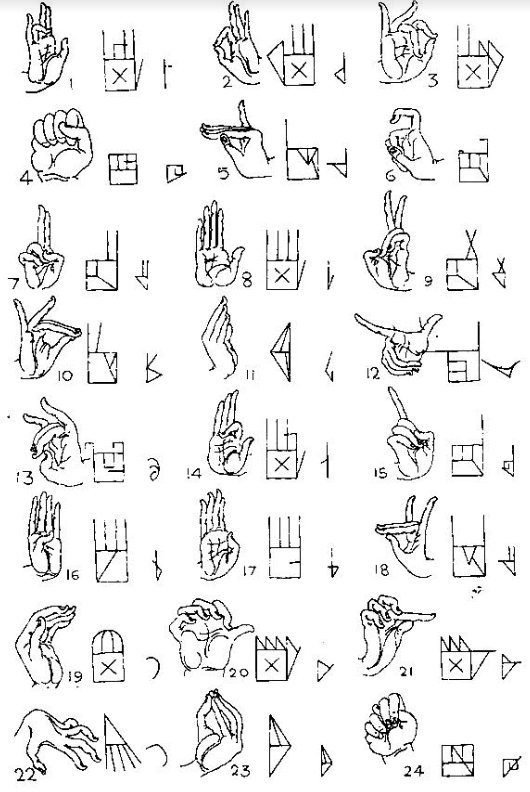 Alphabet representing the 24 basic mudras of Hastalakshanadipika Mudras are the alphabets which have been represented in the 24 basic mudras of Hastalakshanadipika. In chapter 6 of the compendium, alphabets of basic mudras have been illustrated with the three views of the hands. Symbols denoting the different directions of the palm, which are generally of help in portraying every mudra. Detailed movements of the palm with the wrist; finger movements have all been illustrated, besides other symbols. Chapter 7 deals with Kutiyattam-the Sanskrit Theatre of Kerala along with its full history as well as what it means in the present times. Chapter 12 is both important and interesting. Here Venuji has spelt out Ramayana Samkshepam Attaprakaram with notations of mudras accessible to Kutiyattam aspirants. Of all the ancient forms of classical dramatic performances in India, the one still living is Kutiyattam, which adheres to the acting technique elaborately described in Bharata's Natya Sastra, the basic book of Indian dramaturgy, though a closer look will reveal that it has its own modes in many aspects which are different from what is propounded in Natya Sastra. Perhaps Kutiyattam preserves the theatre that was specifically South Indian, a full-fledged form that was in existence even before Natya Sastra. From the starting line of Ramayana Samkshepam attaprakaram, which runs thus "once upon a time the sun dynasty existed" to the finish with Rama suggesting agnipravesha for Sita and her disappearance under the earth on account of her rage; Rama's secret conversation with Antaka; his dip into the Sarayu river before discarding his human form and attaining his divine form to finally reach Ksirabdhi with the help of Garuda, his vahana, in the company of Lakshmi and Dhatri to recline on the serpent, and sleep comfortably, has been etched with clarity, leaving no room for doubt to future generations of students of Kutiyattam to give shape to the story. It's an amazing piece of work. One man's toil has achieved in ensuring the continuity of an art form which is an intangible heritage of mankind. The subsequent chapters deal with "Nama Mudra"- hand gesture for name and notations of mudras illustrated vividly which will enable a student to give shape to movements. As it appears, Notations of mudras is a virtual teacher – it is an encyclopaedia where aspirants may recapitulate movements forgotten or actually learn Kutiyattam for the first time. For substantiation, I quote examples from the Notations of mudras which has pictorial representations of "once upon a time", "sun", "relating to", "dynasty", "happened" etc. In fact gestures for name or 'Nama Mudra' in Kutiyattam have 260 notated mudras in all. The idea or concepts that need to be expressed through 'Nama Mudra' in Ramayana Samkshepam are given in detail in this book. Kutiyattam mode of acting through hand gestures was evolved in the course of enacting various eventful stories. The system was developed centuries ago. The rich heritage of Kerala which flourished for centuries gave birth to Kathakali in the 17th century. In the chapter of Notations of the Hastamudras Part One, Venuji has listed 637 Kathakali mudras he has collected from some of the noted exponents of the Southern style. The notation of mudras given in this chapter is not entirely based on Hastalakshanadipika, because all the 24 basic gestures in this treatise have not been accepted in its totality in Kathakali. However gestures for their practical application have been used from other sources and usages as well. In order to write a complete dictionary on Kathakali mudras, three manuscripts were prepared. This part of the Notations of the Hastamudras happens to be the first of the three manuscripts. The inter-connected mudras have been grouped together here. Pages 306 to 535 pictorially detail the words that can be shown through the 24 mudras. As a student of English language, I found that in the language of mudras all the 8 Parts of Speech used in English language such as noun, verb, adjective, adverb, preposition, pronoun, conjunction and interjection are there. There is a clear indication to the readers that Kathakali is a complete language by itself, where mudras are capable of expressing ideas in simple language as well as in phraseological and idiomatic ways too. It also has punctuation marks. The Notations contain a complete language which a dancer can use. Both connoisseurs and the lay persons are empowered with knowledge of the language of mudras for an aesthetic enjoyment of a drama.   Notations of Mudra A separate section authored jointly by G. Venu and Nirmala Panikar is on the attaprakaram with Notations of Mudras and postures of Mohiniyattam. Kerala is a land where culture is the staple food of the people. It abounds in dance forms like Tullal, Kuttu, Kutiyattam, Kathakali, Krishnanattam, Teyyam, Patayani and others. Amongst them, Mohiniyattam holds its pride of place. It has been patronised by royals, the musical aspects of which were enriched by Maharaja Swati Tirunal and Irayimman Tampi - a poet and musicologist respectively. The hand gestures used in Mohiniyattam are mostly from Hastalakshanadipika; over and above these some mudras have been adopted from Abhinaya Darpana and Balaramabharatam as well. Chapter 28 of the book has included the Attaprakaram and notations of five popular Padams and one verse in Cholkkettu used in Mohiniyattam. The words of the Padams are numbered and the relevant notations carriy the same number. Scope is there for manodharma acting, to be altered depending on the imagination and versatility of the dancer. According to the views of the writer, "An art form like dancing has to be learned directly from a teacher through practical training. This kind of documentation is intended only as an aid to dispel doubts that may arise after a course of training." Very significantly the book Mudra has been dedicated to the lotus feet of the great Guru Abhinavagupta, the rarest of the rare genius who perhaps lived in 10th century A.D. in Kashmir and who had lived a life with dance, music and percussion, after attaining practical and theoretical knowledge in all the art forms as well as the spiritual literature of India. Abhinavabharati - a commentary on Bharata's Natya Sastra - has been written by him. "Time carries us across our creative endeavors and life itself presents ever-present opportunities. It is fascinating to see the beauty and knowledge of the past informing the present shaping an invisible future," said Arthur Koestler, in the foreword of the book. Art basically is the mirror of the people. It is the identity of a people. The act of preservation of art is vital for it to survive. The Guru-shishya Parampara has played a great role in maintaining an uninterrupted tradition which has continued from ancient times. Through this method, memory was transmitted from one generation to another. The crumbling tradition of not adhering strictly to the guru-shishya tradition has given birth to the idea of preservation of knowledge through the system of notation and writing. The encyclopedia Britannica under the written documents of movement defines dance notation as 'recording of dance movement through the use of written symbols' -the system through which actual dance movements could be captured and constructed. With dance the notation process needs to direct its translation to movement. Venuji's method has precision and clarity. It is unique. He has been successful in helping in the continuing of tradition - its ancient form, as well as to comprehend, study and nurture the 'art tree', which is our identity, upholding the 'spirits' that are inherent in our culture. And that's the only way art forms will live. The aims and objectives of this book is to preserve the performing art traditions with a focus on research, training, and innovations. With this aim in view, G. Venu has spent his valuable time of over 60 years with his work on notation, which will help dancers and scholars of future generations. Not satisfied with a plethora of experimentation, he has also validated his work with precision and insight all along. The book is the result of his life time effort whose shine promises to be everlasting. It is worth knowing that in 1986, The Grolier Club of New York and the Harvard Theatre Collection published '400 years of Dance Notation' by Beri Clarke where G. Venu's name features on this list along with the greatest pioneers across the world. His name was recorded on the chronology table alongside Feuillet, Stephanov, Laban, Benesh, Cunningham, Sutton, Nijinsky and so on. His name was the only submission from Asia. All the hand gestures used in the book are notated using VENOTATION - the notation system formulated by G. Venu in 1965. It was published for the first time in 1968 as 'Alphabets of Hand Gestures' in Kathakali. N.V. Krishna Warrior, a person of eminence, has said, "His drawings portray the gesture-language of Kathakali in its dynamic form so that a person familiar with these drawings can very easily understand and enjoy an actual performance of Kathakali without any formal initiation." Eminent scholar Kapila Vatsyayan has said, "Sri G. Venu appears to have succeeded in evolving a system of notation which can respond to the characteristic features of Indian dancing. The system is innovative logical and viable. It takes into account practically all the physical possibilities of the palm and the finger movements and combines an approach of using symbols with simple pictographs. Direction, facings and path of movement is all taken care of. It is then related to body posture and stance, place and covering of space. It is easy to follow and once the rudimentary principles are learnt, the notation system presents little difficulty. The system can be applied to other dance forms as well with some minor modifications." The book is a storehouse of knowledge for critics too. Well known critic Shanta Serbjeet Singh had hailed it as the revelation of a rare world to the people. Peter Oskarson, Eberhard Fischer and Bent Home have found Venuji's work to be a highly developed concept. "A thought-provoking mapping out the basis of the profound pleasure you experience from that specific refined art." This book and the history within it belong to all of us. It is original. Its sole aim is to keep alive collective memory of what was, what is and what will be. This compendium "Mudra" promises to be as beneficial and good as the ancient treatises on music, dance and drama. The name of G.Venu will be etched in gold and will go down in the history of the performing arts. He has surely left a mark. In the words of Swami Vivekananda, "As you have come to the world you must leave some mark behind." 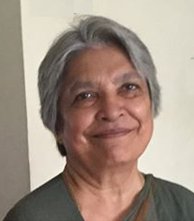 Tapati Chowdhurie trained under Guru Gopinath in Madras and was briefly with International Centre for Kathakali in New Delhi. Presently, she is a freelance writer on the performing arts. Post your comment Please provide your name / email id when you use the Anonymous / blog profile to post a comment. All appropriate comments posted in the blog will also be featured in the site. |